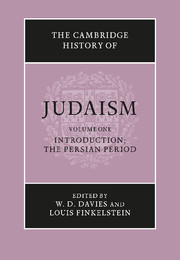Book contents
- Frontmatter
- INTRODUCTION
- THE PERSIAN PERIOD
- 4 The Persian empire and the political and social history of Palestine in the Persian period
- 5 The archeology of Persian palestine
- 6 Hebrew and Aramaic in the Persian period
- 7 The Jewish community in Palestine in the Persian period
- 8 Prophecy and Psalms in the Persian period
- 9 Wisdom literature in the Persian period
- 10 Jewish religious life in the Persian period
- 11 Persian religion in the Achemenid age
- 12 Iranian influence on Judaism: first century B.C.E. to second century C.E.
- 13 The Diaspora
- Bibliographies
- Chronological Table
- Index
- References
5 - The archeology of Persian palestine
from THE PERSIAN PERIOD
Published online by Cambridge University Press: 28 March 2008
- Frontmatter
- INTRODUCTION
- THE PERSIAN PERIOD
- 4 The Persian empire and the political and social history of Palestine in the Persian period
- 5 The archeology of Persian palestine
- 6 Hebrew and Aramaic in the Persian period
- 7 The Jewish community in Palestine in the Persian period
- 8 Prophecy and Psalms in the Persian period
- 9 Wisdom literature in the Persian period
- 10 Jewish religious life in the Persian period
- 11 Persian religion in the Achemenid age
- 12 Iranian influence on Judaism: first century B.C.E. to second century C.E.
- 13 The Diaspora
- Bibliographies
- Chronological Table
- Index
- References
Summary
CLASSIFICATION OF THE MATERIAL
Between the years 545 and 538 b.c.e. the whole of the Middle East – including Palestine – was conquered by the Achemenid kings of Persia. At that time the Persian empire, the largest of the empires of the ancient world, extended from North Africa to southern Russia and from Asia Minor to India. In the days of Darius I (522–486 b.c.e.) its borders were consolidated and its interior division was determined. According to this division some twenty satrapies were established, each of which was divided into numerous sub-provinces (see the description in the book of Esther 1: 1 ‘from India even unto Ethiopia, over an hundred and seven and twenty provinces’).
The whole of Palestine constituted only a tiny part of one of these satrapies, namely the country ‘Beyond the River’ (Ezra 4: 10–11), a term which was borrowed from the former Assyrian administration and perhaps from an even earlier period (see 1 Kings 4: 24). The province of Beyond the River included, in addition to Palestine, Syria, Phoenicia and Cyprus. According to Herodotus (111.5) its northern border was in Poseideion (now al-Mina at the mouth of the Orontes) and its southern border was at lake Sirbonis (Bardawil lake).
The sub-division of Palestine appears to have been based on the older divisions of the Assyrian and Babylonian administration, probably related to the territorial boundaries of the various peoples living in the country during that period. The best known of these provinces were Megiddo, Dor, Samaria, Judea, Ashdod and Gaza. At the head of each province was a Persian governor or a local representative who was responsible to the satrap of Beyond the River for its efficient administration, payment of taxes and the like. This state of affairs lasted for some two hundred years in Palestine, from 538 to 332 B.C.E., in which year the entire Middle East was conquered by Alexander the Great.
- Type
- Chapter
- Information
- The Cambridge History of Judaism , pp. 88 - 114Publisher: Cambridge University PressPrint publication year: 1984

